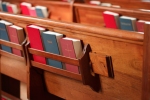November 2017
Vision and Planning
Investing in a Multiracial Vision of Church
I recently attended a weekend-long antiracism training alongside other laypeople and clergy from the Diocese of Chicago. Participants were presented an informational sliding scale and asked to “rank” our organizations in terms of our commitments to mobilizing against white supremacy. This was a challenging, thoughtful exercise which encouraged us to engage necessary, pointed questions. As a diocese, are we shoring up white exclusion and power, have we moved towards a decorative and superficial multiculturalism, or do we evince active organizing against institutionalized racism in every facet of our shared life?
My church’s parish office has a lovely monthly calendar of Episcopal-influenced comics. One of my favorites, “A Parable of Episcopal Evangelism,” depicts a tidy fish tank lying in the sand next to a rolling sea. The caption reads: “It is likened unto an aquarium set by the ocean’s edge. Any fish from the ocean are invited to jump into the aquarium if they happen to be passing by and feel like it.” This is certainly how our historic commitments to diversity and multiculturalism have operated in our churches: Come In, We Don’t Care Either Way. Many disenfranchised people have been hesitant to become a part of our denominational structures because of their often exclusive character. In many ways, our whiteness has impugned our public witness, and this has largely not been met with serious challenge.
An authentic welcoming
It is often said that a potential member’s first official visit to our congregation will be their exploration of our website. Many churches consequently boast incredible graphic design and manage to brilliantly capture the relational beauty of our community life. In an effort to demonstrate welcome, congregations are frequently sure to plaster colorful faces across their marketing materials. Yet these surface appearances can be deceptive. What other tools may be helpful in analyzing whether we are truly celebrating ethnic difference?
I believe that one of the institutional thermometers that can help us determine how serious we are about our welcome to gender and sexual minorities and communities of color is the state of our finances. That is, our fiscal decisions often speak far louder than lofty words. A budget is an inherently confessional and theological document, revealing our innermost spiritual values; an outside observer should be able to analyze our finances and weigh how much we truly care about this Jesus Movement that we have spilled so much ink over. This raises many practical and uneasy questions. What kinds of radical hospitality are we apportioning or neglecting in our congregations? Are we properly allocating funds, on personal and institutional levels, that reflect our supposed commitments towards serving hurting people?
Last week, my seminary classmates and I visited Trinity United Church of Christ, a congregation which, as part of their belief in the goodness of God’s creation and the healthy stewardship of the natural world, has tangibly “greened” their church in several powerful ways. The parish hosts a weekly farmers’ market of produce grown by black planters, fosters several community gardens, and built an energy-efficient green roof which puts their building to work growing vegetables for the hungry. Many questions were raised for me after my visit: does my church building show a caring, familial relationship with the land, or does its operation mirror cheap, exploitative values? If the God of our faith stands against reckless environmental degradation, why do we consistently budget for so many disposable paper products?
Proactive diversity
While my seminary’s student body is predominantly non-Latinx, many of our churches in and around Chicago’s South Side come into regular and intimate contact with Spanish-speaking communities. Recognizing the hypocrisy of claiming to celebrate cross-cultural values while not being able to exchange words with our neighbors, our school has begun to offer free Spanish language instruction classes. Setting aside the funds to more responsibly interact with our natural environment, and to teach a neighbor’s tongue, will seed countless new healing ministry possibilities.
Yet we do not need to wait for diocesan or seminary partners to implement these changes. In many ways, our congregations can lead the way in this work. Particularly with the resurgent forces of white supremacy fomenting around us, has your vestry considered hosting an antiracism training or basic social justice competency education? If the neighborhood is shifting around your congregation, are you offering English language classes for community members – or foreign language instruction for congregants to better engage others? How is your church garden helping to feed local ethnic community centers, houses of faith, or activist groups? Where we decide to invest, there lie our truest beliefs. In fiscally lifting up multilingual and multiracial church leadership, we go beyond lip service to multiculturalism and diversity, and will come to harvest more fully the richness of our shared ministry.
In the United States, both the way we look and the way we worship continue to shift in seismic ways. It seems clear that the institutional church in the West is groaning, hemorrhaging membership and creaking under shifting demographic weights. Less clear is whether these terrible noises are death rattles or the hazard gasps of birth pangs. What if we are not dying, but on the cusp of something new? What if, in fact, the White Mainline Church as it has historically existed needs to die in order for the church of God to be born? Good stewardship does not mean merely tilling the soil before us, but honoring the atmospheric changes that the future will bring, centering trust and humility. We can adhere to austere financial decisions that reify current members’ comfort, and harken for a 1950’s mom-and-pop church “golden days” that never were. Or we can turn a critical eye to our capital and whom it serves, and lean into the Jesus-shaped movement that God is calling us to today.
Kenji Kuramitsu is a writer and Master of Divinity student at McCormick Theological Seminary. Kenji works with diverse faith communities to forward conversations about LGBTQ equality and racial justice. He currently serves on the board of directors of the Reformation Project and the Japanese American Citizens League.
His newly-released prayer book, “A Booklet of Uncommon Prayer” published by Evangelicals for Social Action, is available for purchase here.
Resources
- Our Call to Leadership, by Lelanda Lee, Vestry Papers, May 2012
- Lift Every Voice by Anna Olson, Vestry Papers, January 2015
- Putting Out Signals by Anna Olson, Vestry Papers, November 2014
- Understanding and Celebrating Differences by William M. Kondrath, Vestry Papers, January 2011
- Walking the Road of Relationship by Sarabeth Goodwin, Vestry Papers, November 2015






